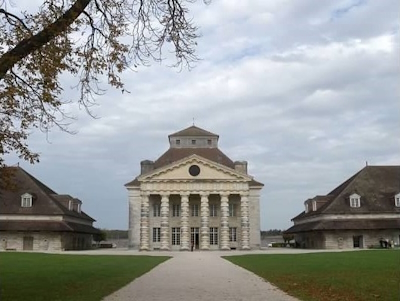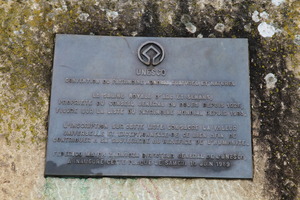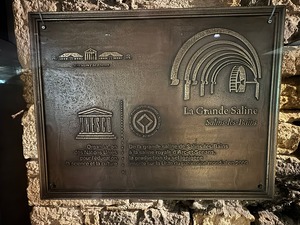Royal Saltworks of Arc-et-Senans

"From the Great Saltworks of Salins-les-Bains to the Royal Saltworks of Arc-et-Senans, the production of open-pan salt" represents the extraction and production of salt from the Middle Ages to the 20th century.
The Royal Saltworks of Arc-et-Senans was an early Enlightenment architectural project to rationalize industrial buildings and processes. They were connected by a pipeline to the older saltworks of Salins-les-Bains, where salt was retrieved from deep underground.
Community Perspective: This is one of the more imaginative WHS of France. At Salins-les-Bains you can do an underground visit to the mines, while at Arc-et-Senans a Utopian work of architecture awaits (you can also stay overnight here in one of the original buildings that has been turned into a hotel).
Map of Royal Saltworks of Arc-et-Senans
Community Reviews
Klaus Freisinger

This is a very interesting site consisting of 2 separate components located near the Swiss border. I set out to visit both places by public transport from Besancon in one day. The train ride from Besancon to Arc-et-Senans is straightforward and very short, and the salt works are just a few steps from the station. As stated in the other reviews, Arc-et-Senans is mostly about architecture and urban planning, and the creation of a model city that was never fully realized. It is very pleasant to walk from building to building, which are set up in a semi-circle, and also to explore the surrounding gardens. The buildings have different purposes, from hotel rooms to exposition space (including a nice exhibit on World Heritage sites), and it takes a few hours to see everything. I then took the train to Mouchard and waited for a bus to Salins-les-Bains that didn't come (apparently I had misread the schedule, because there are fewer buses in summer, during school holidays). The lady at the SNCF ticket counter was nice enough to call me a taxi so that I could arrive at Salins-les-Bains (about a 15-minute drive away) in time for the German guided tour (they started with these this year, and tours are also available in English, at least in summer). They take you underground and give interesting explanations about salt extraction and the lives of the miners; some parts date from the 12th and 13th centuries. Afterwards, you also see a building aboveground that contains original artifacts such as salt pans. In the late afternoon, I took a bus from Salins-les-Bains (which is by the way a very pretty town with a nice historic centre) to Mouchard, from where I caught a train to Besancon. Taken together, both sites provide an interesting overview of the trouble taken to provide people with salt, which is of course not only needed for health reasons, but in the past was also used to cure meat and as a form of payment (where the word "salary" comes from).
Els Slots

From the Great Saltworks of Salins-les-Bains to the Royal Saltworks of Arc-et-Senans, the production of open-pan salt is one of the more imaginative WHS of France. With an admission date of 1982, it also is one of the earlier sites on the WH List. So I was really looking forward to visiting, and it did not disappoint. I even had wanted to stay overnight at Arc-et-Senans, but when I checked 2 months beforehand the on-site hotel La Saline Royale was already fully booked for the date that I wanted.
My planned visit on a Sunday in March left me with a dilemma: because of the limited opening hours during the winter season, I only had time to visit 1 out of the 2 inscribed locations (Arc-et-Senans or Salins-les-Bains) properly. I eventually chose Salins-les-Bains, as its features are mostly underground and less weather dependent. The site lies in the French Jura, quite a trip through the countryside away from the nearest tollway exit.
During the weekend's off-season there are 3 daily tours of the underground saltworks. They are all conducted in French, although foreign speakers are provided with a leaflet in English. The stories of the guide are much more detailed though than what’s available on paper: you can download an audio guide in your language beforehand for your phone, but I forgot to do that. So I did my best to understand the French explanations.
The 1-hour tour teaches you everything that you never knew about salt. The product was so valuable in its heydays that the big Salins-les-Bains complex only had one small exit, where the labourers were checked every day so they did not smuggle salt to the outside world with them. The factory at Salins-les-Bains was purposely built near a forested area to provide for its high-energy approach to sustain the artificial evaporation process. The main distinguishing feature of Salins has been described by ICOMOS as “extraction techniques, notably the existing underground facilities, which testify to the pumping system and the production of open-pan salt”.
There’s always some excitement about an underground tour, though I must say that there aren't many original features left. The saltworks here were based on preserved layers of salt beneath the ground. Via an extraction process (partly done by horses and later using water wheels), the brine would be pumped into pans and concentrated by the heat of the fire burning underneath. As crystals of salt formed these would be raked out and more brine added. The huge drying racks and fans can still be seen.
I left Salins-les-Bains just past noon, and decided to make a short detour to Arc-et-Senans. Both of the Saltworks were linked together by a double-pipe system. This main location is situated some 20 minutes northwards and is only open from 10-12 and 14-17. But I hoped to still get a glimpse of this highlight of classicist architecture. Well, it wasn’t really worth it: the Royal Saltworks of Arc-et-Senans is fully surrounded by a 3m high wall! The gate was locked and I could only admire the main entrance.
Clyde

I visited this industrial heritage in July 2013. Like Paul, I had no idea what to expect or what I was going to see. Well, my visit to Arc-et-Senans and especially to Salains-les-Bains proved to be remarkable to say the least. This became my favourite industrial WHS! The Royal Saltworks of Arc-et-Senans were interesting mostly for their architecture and utopian planning. I learnt that it is also possible to sleep inside the Royal Saltworks as there are a couple of rooms available for 85euros. This means you'll have the Royal Saltworks almost for yourself in the morning before opening hours. However, the highlight of my visit was the Salt Mine and Museum in Salains-des-Bains. You have to visit with a French-speaking guide but an information sheet in English is provided with a translation of the guide's commentary. The guide was really excellent and really gave an interesting tour. The salt mine machinery is still fully functional. Do try the sweets they sell in Salins-les-Bains with the local salt. Yummy!
Thibault Magnien

The site of Arc et Senans is actually composed of two elements; The first one is the Saline Royale (Royal Saltworks) situated in Arc et Senans. It has been built during the 18th century by the famous French architect Claude-Nicolas Ledoux and is a great testimony of an Enlightenment project on one hand, and of an industrialized planned city, designed for a specific task, salt treatment, on the other hand. The city has been planned as a 'Perfect city' with all the building necessary for its people from school to church passing by hospital and accommodations.
The second element is the great saltwork situated in Salins les Bains, 20km from Arc et Senans. In this city you will be able to experience the guided visit of the museum that begins under the ground, with the salt mine and finish outside, in the furnace room where salt blocks were treated.
John booth

I reached Arc-et-Senans by train from Besancon and returned to Dole. Salines Les Bains can be accessed by bus from Mouchard station.
There is an interesting collection of models of buildings, built and unbuilt, by Ledoux in the tonnellerie.
David Berlanda
Italy / Czech Republic - 07-Mar-06 -

In our trip to France we have visited the beautiful royal saltworks of Arc-et-Senans, constructed from 1775 to 1779 under Louis XVI on the project of Claude Nicolas Ledoux, since 1771 Inspector General of the saltworks of the Jura, a Royal monopoly, and are the only ones built of the ideal cities planned by him for this industrial complex. It is the first work of the industrial architecture, inspired to the ideal of progress of the Enlightenment, built to permit a rational and hierarchical organization of the work. It was constructed to treat the salt deposits by evaporation: the saline water was brought here from Salins-les-Bains, 21 km away, and channelled by a system of double canalization composed of wooden cylinders and protected by control towers, manned by the Army. The water was evaporated in huge vats heated by fire with wood taken from the forest of Chaux. The buildings functioned until 1895. The city was organized around a factory whose buildings were layed out in a semi-circle around the Pavilion of the Director (with the stables behind it), flanked by two halls, the firing ateliers, where were the vats. The semi-circle was used for lodgings and workshops of the coopers, the blacksmiths, the workers and the ironsmiths, for the guards' building (the entrance) and for the buildings of the administration of the saltworks and of the administration fiscal. As its symmetrical counterpart, Ledoux had foreseen another semi-circle with a church, an exchange, a hospital, a market, public baths... The revolutionary architecture of the buildings, inspired to the Doric and Tuscan styles use geometric volumes with many inventions, like the ringed columns of the pavilion and of the overseers, a grotto with concretions that evoke melted salt...
I liked this site because of the quality and originality of its architecture. It's one of the most interesting industrial sites and it's worth to be visited if you are in the region of France County. It justifes the inscription also because there aren't many other industrial sites on the WHL, even if could be inscribed together with the nearby saltworks of Salins-les-Bains (currently on the Tentative List).
Photo: Arc-et-Senans - Pavilion of the Director and firing ateliers of the Royal Saltworks
Solivagant

When we visited the Royal Saltworks of Arc-et-Senans we were not really aware of what we were going to see. We were somewhat surprised to discover a site much broader in concept than the title might imply. It comprises a planned town of the late 18th century which was developed around a factory to produce salt from nearby saline deposits in the Jura using wood from local forests as the fuel. As a product of the Enlightenment it is set out on “rational” grounds in a semi circle (although in its original concept it was to be a full circle). Some of the buildings (photo) follow classical designs. A lot of reconstruction has taken place – it was badly damaged by fire in 1918 and a dynamite explosion in 1926. A number of the buildings (each had a very specific purpose in the overall design and that of the “Overseer” is a fine structure) are open and contain exhibitions showing the history and production processes.
The site presents an interesting example of 2 different WHS themes, Town Planning and Industrial Architecture, whose development can be traced across other eras and countries elsewhere in the list (eg New Lanark and Brasilia!). It is for that reason, in my opinion that Arc-et-Senans, justifies its inscription. Michelin may only give it 1* and it is true that the buildings and exhibits taken individually are nothing special but, taken as a whole, and as part of the wider concept, it is well worth visiting.
Community Rating
- : Nikolay Marinov Yevhen Ivanovych
- : Thibault Magnien Aspasia MoPython Szucs Tamas Christravelblog Jeanne OGrady MaxHeAnouBen Zoë Sheng Laurine WalGra
- : Craig Harder Christoph Alexander Lehmann WILLIAM RICH Caspar Dechmann Martina Rúčková CugelVance Roel Sterken
- : Dorejd GeorgeIng61 Els Slots Shandos Cleaver Jean Lecaillon Klaus Freisinger Peter Lööv Dwight Zehuan Xiao MH Flexiear Mahuhe Csaba Nováczky
- : Ivan Rucek Solivagant Nan Argo Shijie ZHU Frederik Dawson Hubert Philipp Leu Daniel C-Hazard Randi Thomsen
- : Thijs van den Berg Walter Clyde Svein Elias Joyce van Soest Tarquinio_Superbo Jezza David Berlanda Hasco Philipp Peterer Wojciech Fedoruk
- : Dirk-pieter
Site Info
Site History
2009 Extended
To include Great Saltworks of Salins-les-Bains
2009 Name change
From "Royal Saltworks of Arc-et-Senans", To: "From the Great Saltworks of Salins-les-Bains to the Royal Saltworks of Arc-et-Senans, the production of open-pan salt"
1982 Inscribed
Site Links
Unesco Website
Official Website
Related
Connections
The site has 17 connections
Art and Architecture
Constructions
Geography
History
Human Activity
Timeline
Trivia
WHS Hotspots
WHS Names
World Heritage Process
Visitors
189 Community Members have visited.
The Plaque
 (photo by Clyde)
(photo by Clyde) (photo by Christravelblog)
(photo by Christravelblog)